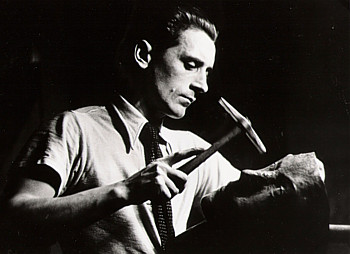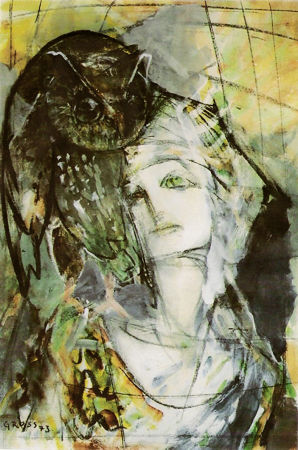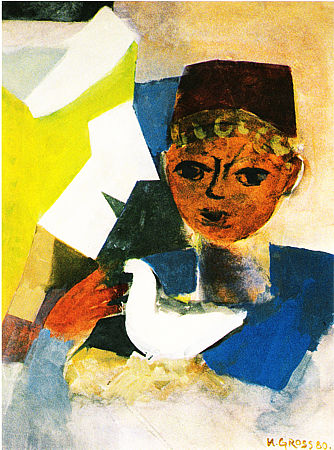In the February and April issues of CYC-Online I described the way in which Hermann Gross, an artist-in-residence in a child care setting in Scotland, was able through his paintings to reflect upon certain features of life in that setting (Plate 1). Before taking a final look at Gross’s paintings, I would like to refer to the work of one of Gross’s teachers – Waldemar Raemisch.

From 1919 to 1923, Raemisch taught at the High School of the Museum for Arts and Crafts and then became a professor at the State Academy of Fine and Applied Arts in Berlin. Working between the two world wars Raemisch designed, among other things, the bronze eagles at the entrance to the Olympic Stadium in Berlin. Forced from his professorship in 1937 because his wife was of Jewish descent, Raemisch emigrated to the USA. He was invited to the Rhode Island School of Design and officially took up post in September 1939. From 1946 to 1954 he was Head of the Sculpture Department. The last two bronze sculptures that Raemisch completed are perhaps his best known.
The sculptures in question are The Great Mother (Plate 2) and The Great Doctor (Plate 3) which were unveiled in 1955 and located on the Benjamin Franklin Parkway in Philadelphia. The Parkway forms part of an ambitious and spacious city layout featuring long tree-lined avenues designed by Jacques Gr–ber in 1917 to emulate the Champs-–lys–es in Paris. For over five decades these sculptures were situated outside the Youth Study Center (juvenile prison) on the Parkway: a somewhat incongruous location for a penal institution. Because of the proposed demolition of the Center, the sculptures were moved in 2008 to The High School of the Future in Fairmont Park in Philadelphia.

Both sculptures are made up of a seated, central figure surrounded by children and adults. The Great Mother and The Great Doctor are meant to serve as positive role models for children by representing society’s caregivers, comforters, healers and guides. The sculptures were initiated by the City of Philadelphia to epitomise the spirit of children and their need for nurturing and care. In receiving these sculptures at Fairmont Park in 2008 the School District Superintendent, Dr Ackerman, observed that: “exposure to the arts on a daily basis is an essential part of public education and lifelong learning”. The architecture critic of the Philadelphia Inquirer, Inga Saffron, described the sculptures as moving works of art that raise their nurturing subjects to an iconic status. I am unaware of any civic monuments in Europe or North America which elevate and celebrate the themes of healing and caring. The placement of the two large bronze sculptures on a deep concrete base serves to illustrate – in an allegorical fashion – the importance for children of a sure and firm formation within the family.

What is immediately striking about these compositions is that members of each group are not wearing contemporary dress. We are being invited to return to an earlier age. There is something in the solemnity and solidity of the two groups and the modesty, simplicity and style of the female dress to suggest a puritanical reference. Raemisch would have known something of Philadelphia’s history and the debt owed by the city to its Quaker founders. What is pertinent here is that Quaker social reformers in the USA and UK have always been concerned with honouring, protecting and nourishing the creative vital forces that give rise to life and to our human identity. And it is no coincidence that over the past two centuries many innovative, imaginative and successful education and social care programmes have been pioneered by Quakers – not least in the field of penal reform. The original juxtaposition of these two statuary groups alongside a juvenile prison may have been to highlight in the most public manner possible the risks that society takes when caregivers fail to fulfil their familial and societal obligations.
Let us now return to an examination of the art of Hermann Gross. Intriguingly the painting in Plate 4 departs from Gross’s customary semi-abstract form.

The subject may at first sight appear bizarre until one realises that the woman represented in the painting is Athena “the goddess of wisdom. Athena is frequently depicted with an owl either on her head or shoulders. As for the owl itself, in Western culture it has two major symbolic meanings; one is as an incarnation of wisdom and the other a harbinger of death or evil. As Gross never explained the meaning of his paintings it is necessary to be cautious in attempting an explanation. Could it be that only in death do we achieve true wisdom “a possible allusion to anthroposophical beliefs? Or could it be that only through engaging in the arts and crafts “painting, sculpting, weaving, pottery, wood and metal work “does one gain a true appreciation of and respect for our material and spiritual existence, for Athena was also the patroness of arts and crafts “activities strongly promoted in Camphill communities.

To understand the painting of the boy and dove illustrated in Plate 6, it is necessary to be aware of some of the symbolism associated with the dove. To the Egyptians the dove was a symbol of quiet innocence, whilst to the Greeks and Romans the dove represented love and devotion and care for the family. The most famous work involving a child and dove is that painted by Picasso in 1901 (Plate 5). In this painting a boy is shown gently clutching a dove closely to his body. This combination of child and dove reinforces the impression of innocence and vulnerability. Gross will certainly have been aware of this work, not least because before the Second World War, he had been one of Picasso’s students in Paris.
What is disconcerting in Gross’s painting is the way in which the faces of boy and nurse are counterposed. By portraying the nurse without eyes is Gross hinting that she is blind to the delicate nature of the relationship that exists between her and the child. Is the fact that the child's eyes are wide open meant to suggest that he has a better understanding of that relationship? In other words, is Gross suggesting that the capacity of children to understand their situation should never be underestimated?

The sharp angular profile of the nurse’s face looks as though it has been scissor cut from a sheet of white paper and superimposed on the painting. Is the nurse’s dehumanised appearance meant to convey her professional image? This may seem an outrageous suggestion. However, Dr Karl Koenig, co-founder of the Camphill Movement, who had invited Gross to Scotland to act as an artist-in-residence, made no secret of his belief that the professional training of nurses robbed them of their ability to care! In a controversial article which he wrote for The Coracle, the periodical of The Iona Community, he questioned the value of nurse training:
Every patient should be her child for the period of his illness. To love him and to nurse him, to watch him, to guide and to like him – that is her concern. Not to understand how this or that medicine is working in his body or how this or that physiological or pathological fact is acting upon him. This knowledge keeps her away from her actual presence of mind for the patient’s need.” – (Koenig, 1942: 29)
Koenig’s observations need to be placed in context. When he arrived in Scotland, after fleeing Nazi-controlled Austria, he was already a highly qualified and experienced medical practitioner. However in order to qualify to practice in the UK he needed to “retrain”. This meant attending classes at St Andrew’s University Medical School in Dundee. As a result of the considerable experience he had already acquired, he may well have come to question the purpose, relevance and value of the training he was receiving. In any event he abandoned his studies and by so doing failed to qualify as a medical practitioner in the UK. He claimed that the growing demands on him resulting from the setting up of the first Camphill community left him with too little time for study. However the true reason could well have been increasing disenchantment with the training process.
The issue which concerned Koenig most was the nature of the relationship between the professional and the person in that professional’s care. He made clear his view that the more training an individual receives, the greater is the distance that grows between the professional and the cared for person. So we are presented with a paradox: the more the carer is trained, the less caring she becomes. Whilst it would be surprising if Gross was not aware of Koenig’s thinking on this matter, it is doubtful if he would have given any form of artistic expression to it, if he had not been sympathetic to the view himself.
The argument that Koenig advanced cannot be too hastily dismissed. At one time nurse training in the UK was undertaken largely on the ward with patients and under the all-seeing gaze of the sister and matron. The underlying philosophy here was that you only truly learn by doing and only learn to care by caring. In recent years in an effort to professionalise nursing, the nurse has been taken off the ward and is now to be found in the lecture hall. In education, too, there is a growing recognition that the four year teaching degrees introduced in the 1960s in the UK to enhance the professional status of teaching have not led to a significant improvement in either teacher quality or pupil performance. Indeed the contrary can be argued. The position has been exacerbated by the proliferation of professional protocols and the transient nature of untested but popular theories.
Koenig was convinced that the only way in which carers can properly relate to and meet the needs of those in their care is to live and work with them in community: not for him the artificial arrangement of shift working with different groups of care staff coming on and off duty, for such an arrangement denies often bewildered and disoriented children the continuity, stability and security they urgently need. Koenig was aware that involvement in the highly pressurised setting of a community came at a heavy human cost for it left the carers with little time for themselves. The compensation for this personal sacrifice was the progress made by the children. With the passage of time this Camphill ideal has been difficult to sustain given the presence of new generations of carers who are less willing to tolerate what many see as unjustified incursions into their personal time.
Conclusion
In the three articles on Hermann Gross I have tried to
illustrate the potential value to child care establishments of
appointing artists-in-residence. Whether painter, sculptor, musician or
poet, the artist can bring their own unique perspective to bear on what
they experience. The particular value of art is that it communicates at
so many levels. Through his art the artist-in-residence can address the
intellectual, emotional, psychological and spiritual issues which lie
beyond the competence of most of those conducting conventional academic
research or the periodic mandatory inspection. For Gross, art was not a
self-indulgent activity; it had a social purpose, like much of German
Expressionist art.
Although Gross died in 1988, his artwork is still
displayed on Camphill campuses and the content of his paintings
continues to challenge child care staff to reappraise their professional
practice. His work is important for it poses a series of fundamental
questions about the way in which child care services are currently
delivered. In particular, it highlights those human qualities that
carers need to possess to discharge their responsibilities.
References
Koenig, Karl. (1942). Integration in medicine. The Coracle, 19-31. (January)